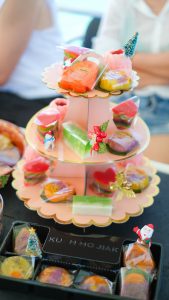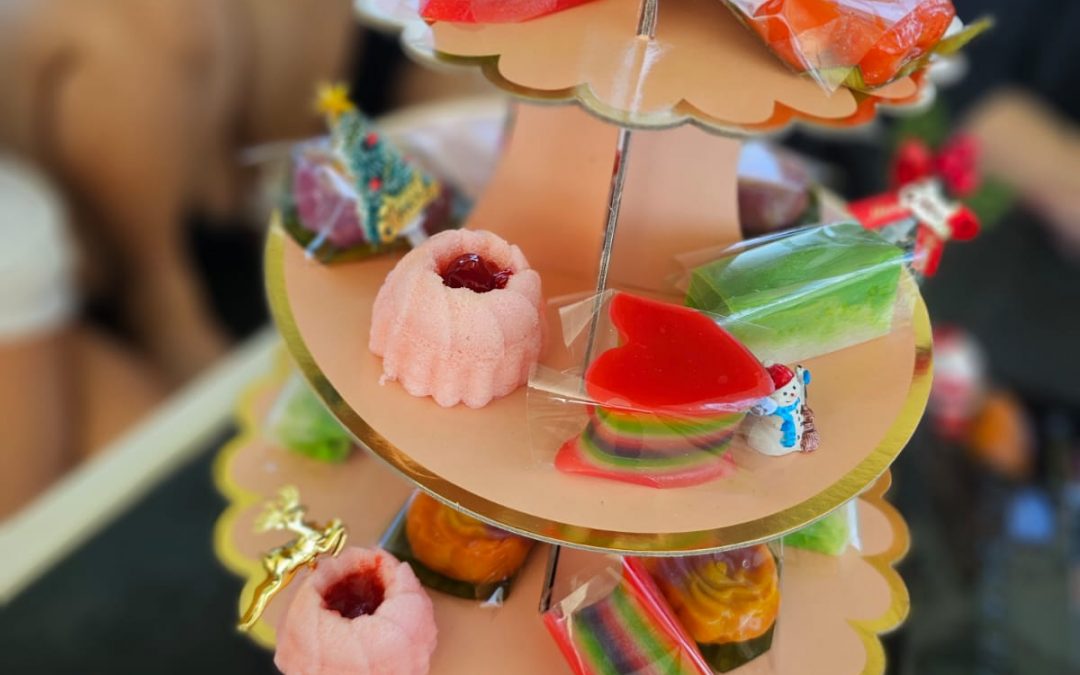Kueh Lapis, also known as “layer cake”, has a rich history rooted in Indonesian and Malaysian culinary traditions. The cake is characterized by its distinctive layers, often with vibrant colors, and it has become a beloved delicacy across Southeast Asia.
The origins of Kueh Lapis can be traced back to the Indonesian archipelago, where it has been a part of festive celebrations and special occasions for centuries.
Over time, the culinary influence of Indonesia spread to neighboring Malaysia and other parts of Southeast Asia, contributing to the widespread popularity of Kueh Lapis in the region.
Here in Singapore, we eat this tasty delight as breakfast or tea breaks whenever possible. It’s loved by all Asian communities in Singapore and it’s a dessert we see many shops still serve today.
However, the hardwork required to create this dessert can be time-consuming. To create these unique dishes, it requires hours of labor to manually pour its flavor gel layers upon layers.
At KuehHoJiak, we do our very best to preserve this heritage for future generations. That’s why our stall is recognized as a heritage hawker by UNESCO. But simply giving recognition isn’t enough to grow the business, to do that, we had to modernize the art of making Kueh Lapis.
Modernizing Kueh Lapis

Here in Singapore, Kueh Lapis is characterized by its distinctive layers, usually with a combination of spiced and sweet layers. The taste can vary depending on the recipe and regional variations based on:
- Spices
- Sweetness
- Buttery and Moist
- Egginess
- Caramelization
It’s an interesting mixture of these 5 tastes that makes this treat delightable. Unfortunately, after finding out that not all of our foody isn’t able to enjoy it due to health restrictions and diet choices.
We decided to pivot!
KuehHoJiak’s Kueh Lapis
To serve more of our customers who are looking for healthier options for kueh, KuehHoJiak’s Kueh Lapis called Yam Purple Lapis is a vegan/vegetarian-friendly dish. Our dish allows more foodies to enjoy our heritage food and we are happy to know our clients come back for our dish.
If you would like to try out our Yam Purple Lapis, you can order it directly through our product page below (PS. Only serving in Singapore!):
Try Our Kueh Lapis By Ordering Here
How Long can Kueh Lapis Last?
Generally, Kueh Lapis can last for several days to a few weeks if stored properly. However, Kueh Lapis should be eaten on the day itself for it to retain its butter and moist texture. If you do plan to store it for later consumption, here are some tips to help extend the shelf life of Kueh Lapis:
- Refrigeration: Storing Kueh Lapis in the refrigerator can help slow down the staling process and prevent the growth of mold. Wrap the cake tightly in plastic wrap or aluminum foil to minimize exposure to air.
- Airtight Container: Place the Kueh Lapis in an airtight container to protect it from moisture and odors in the refrigerator. This will help maintain its texture and flavor.
- Room Temperature: If you plan to consume the cake within a few days, it can be stored in a cool, dry place. Again, keeping it in an airtight container will help preserve its freshness.
- Avoid Sunlight: Keep the Kueh Lapis away from direct sunlight, as exposure to sunlight can accelerate the staling process and affect the quality of the cake.
- Freezing: If you want to extend the shelf life even further, consider freezing the Kueh Lapis. Slice it into portions, wrap each slice tightly in plastic wrap, and store them in a freezer-safe container. Frozen Kueh Lapis can last for several months.
Always use your judgment and check for any signs of spoilage, such as off smells, changes in color, or mold growth, before consuming Kueh Lapis which has been stored for an extended period.
FAQ
- Why is Kueh Lapis so expensive? Kueh Lapis is relatively expensive due to its intricate and time-consuming preparation process. The layering of the cake requires precision and skill, making it labor-intensive. Additionally, quality ingredients, such as butter and spices, contribute to the overall cost. The intricate design and rich flavor also add to its value, making it a special and premium treat.
- What is Kueh Lapis made of? Kueh Lapis is primarily made from ingredients like flour, butter, sugar, eggs, and sometimes condensed milk. The distinct layers are achieved by spreading thin layers of batter and baking each layer individually. Spices such as cinnamon and nutmeg are often added to enhance the flavor and aroma of the cake.
- What is the shelf life of KUEH Lapis? The shelf life of Kueh Lapis can vary depending on storage conditions. When kept in an airtight container and stored in a cool, dry place, it can last for about one to two weeks. Refrigeration may extend its shelf life. However, it’s essential to consume it within a reasonable time to enjoy its freshness.
- Where did Kek Lapis come from? Kek Lapis, or layer cake, has its origins in Indonesia. It is a traditional Indonesian cake that has become popular not only in Indonesia but also in neighboring countries like Malaysia and Singapore.
- What is the history of KUEH Lapis legit? The history of Kueh Lapis is deeply rooted in Indonesian culinary traditions. Over time, it has evolved, and various regional influences have shaped its preparation methods and flavors. While its exact origin is not pinpointed, it remains an iconic part of Indonesian and Southeast Asian cuisine.
- What is the symbolism of Kueh Lapis? Kueh Lapis is often associated with celebration and auspicious occasions. The layers symbolize prosperity and good fortune. The rich, vibrant colors of the cake also make it a visually appealing dessert, adding to its significance during festive events.
- What is a fun fact about KUEH Lapis? A fun fact about Kueh Lapis is that its name, “Kueh Lapis,” translates to “layered cake” in Indonesian. The cake’s distinct layers and intricate design make it not only a delicious treat but also a visually stunning dessert.
- Is Kueh Lapis a Peranakan? Kueh Lapis is not exclusively Peranakan, but it has become a popular and cherished treat in Peranakan cuisine. The Peranakan community, also known as Straits Chinese, has incorporated Kueh Lapis into their culinary traditions, contributing to its cultural significance.
- Is Kueh Lapis Indonesian? Yes, Kueh Lapis is originally Indonesian. It is a traditional Indonesian cake that has gained popularity across Southeast Asia. While it is enjoyed in various countries, its roots trace back to Indonesia, where it is an integral part of their culinary heritage.


Recent Comments